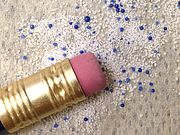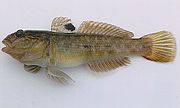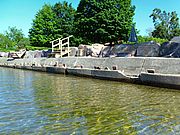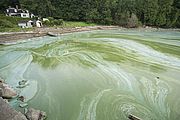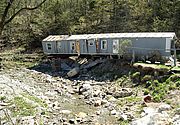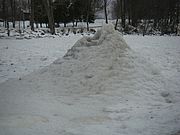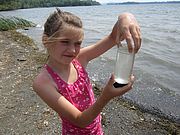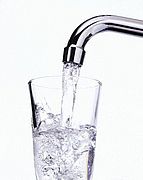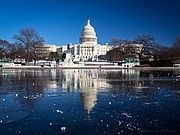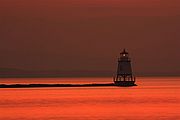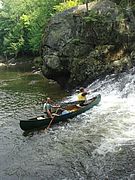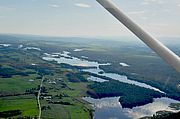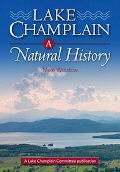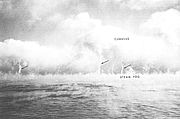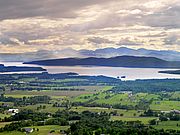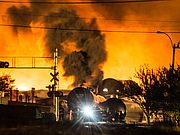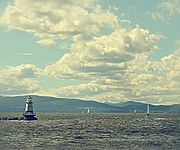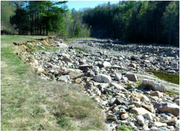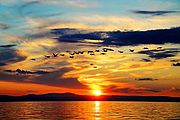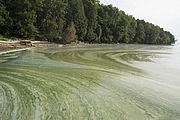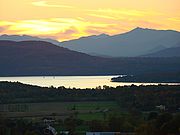Earlier this week the Vermont House unanimously approved H.4, a bill to ban the manufacture and sale of harmful plastic microbeads from personal care products and over the counter drugs. These plastic beads are problematic because they wash down drains, slip through wastewater treatment plants and end up in our waterways. Read...
News from Selected Month
The spiny waterflea arrived in Lake Champlain last summer, becoming the 50th invasive species in the lake. We know it won’t be the last. Recently, a group of environmental professionals discussed what species posed the greatest risk of being the next arrival. Three likely candidates were round goby, hydrilla, and VHS. Read...
Since 2011 the region has made considerable investments in preparing for future floods. We all want to be more resilient when disasters like Tropical Storm Irene or the lake flooding of 2011 come about. Read...
Last August a blue-green algae bloom over the water treatment intake for Toledo, Ohio caused the city to test for the presence of microcystin, a toxin produced by some blue-green algae species. They found more than 1 part per billion of microcystin in the finished water, with concentrations peaking at about 2.5 parts per billion over the next two days. Read...
The flooding from Tropical Storm Irene made tangible the community costs that can occur when landowners develop floodplains. Homes and structures built too close to the water washed away becoming dangerous projectiles and in some cases damaging bridges or downstream properties. Read...
While skating along the flat clear ice of Mallets Bay four or five years ago, Jamie Leopold noticed a geyser of water shooting straight up into the air – 30 to 50 feet high. He may have witnessed a particularly large ice volcano. Read...
On January 21 a truck went through the ice on the banks of Fort Ticonderoga. Luckily both the driver and passenger made it out safely but the vehicle is at the bottom of the lake. It's now the driver's responsibility to get the truck out of the water or face a fine.
Read...Read more about algae blooms and nutrient levels, Wisconsin farms pollution reduction, manure in court rulings, how diabetes medication affects fish health, and more. Read...
Join the Lake Champlain Committee (LCC), Satellites, Weather and Climate (SWAC) and Champlain Basin Education Initiative (CBEI) partners as we consider how to structure investigations of the places we live using a variety of technology. Read...
Legislators in Vermont pondering how to fund Lake Champlain clean-up efforts might be encouraged by a new study coming out of the University of Vermont suggesting Vermonters are willing to put up some money. The average survey respondent was willing to pay $40 according to the study. Read...
If you have traveled outside the developed world you are probably aware that safe drinking water is not to be taken for granted. Tourists are routinely told to only drink bottled water or risk dysentery. Not so in the United States where all tap water in the country must meet rigid standards for contaminants. Read...
Key funding for Lake Champlain has been included in the comprehensive budget package passed by Congress last week. At the urging of Vermont Senator Patrick Leahy, the final budget includes a $3 million increase over last year for Lake Champlain through the Environmental Protection Agency’s (EPA) Geographic Program.
Read...In early December TDI New England filed a state permit application seeking approval for construction of a 154-mile underwater and underground transmission line that would deliver 1,000 MW of hydroelectricity to the Vermont and New England grid. Read...
On Wednesday December 17th New York Governor Andrew Cuomo announced that he would ban fracking, the controversial fossil fuel extraction method. LCC strongly supports this move. Fracking involves injecting large amounts of water, sand and chemicals deep underground at high pressures to release oil and natural gas from rock formations. Read...
Legislation passed in early December will add portions of the Upper Missisquoi and Trout Rivers to the National Wild and Scenic Rivers System. Forty-one states and territories now have rivers listed in the system which was established in 1968 to recognize and preserve rivers with exceptional scenic and recreational value. Read...
As climate change continues to bring increasingly intense storms to our region, communities will have to adapt to avoid flood damage. One way to do so is by restoring and protecting wetlands. In part two of LCC’s publication Lessons From the Floods we demonstrate the importance of allowing rivers to have access to their floodplains so that excess water could be stored and slowly released. Read...
Why is ice so hard and slippery? Does Lake Champlain produce lake-affect snow? Why does fog form over the lake on cold days? What is the probability that Lake Champlain will freeze over in any year? Find the answers to these and many more questions in Lake Champlain: A Natural History. Read...
Early winter is the best time to look for steam devils on Lake Champlain. These weak whirlwinds over water develop when cold air moves in over the still relatively warm waters of the lake. Read...
Lake Champlain is breathtakingly beautiful. Spread that beauty around with the purchase of LCC's stunning photo cards. Read...
First day hikes, news from Colchester, changes at Lake Trout and more. Read about water happenings in other parts of our world. Read...
Well you would have if you liked LCC's Facebook page! 'Like' LCC's Facebook page for engaging content, unique phenomena, the latest lake news, and beautiful lake photos. Read...
Rail transport of explosive Bakken crude oil through the North Country has increased dramatically due to tremendous growth in outputs from Canada and the Bakken oil fields of North Dakota. Rail incidents in Quebec, Alberta, Alabama, North Dakota, New Brunswick, and Virginia have led to fires and explosions. Last year's derailment at Lac-Mégantic, Quebec killed 47 people and devastated the community. Read...
Last week EPA held a series of hearings in the Lake Champlain Basin to introduce their proposed phosphorus pollution budget (called a total maximum daily load or TMDL). The budget calls for a 36% reduction in current phosphorus loading to Lake Champlain with watershed specific reductions ranging from a low of 12% in the Isle La Motte section of the lake to a high of 67% in Missisquoi Bay. Read...
Vermont State Agriculture Secretary Chuck Ross issued a ruling that he would not impose best management practices on farmers in northwestern Vermont as a way to improve water quality in Lake Champlain. Read...
The Vermont Agency of Agriculture leveled a $40,000 fine against Leach Farms in Enosburgh Falls for illegal discharge into waters of the state. Workers at the farm flushed out their manure spreader into Bogue Brook, a tributary of the Missisquoi River. Read...
Three years ago Lake Champlain reached record highs and Tropical Storm Irene ravaged the northeast. These and more recent flood events demonstrated the importance of buffers, floodplains, and stable riverbanks and shorelines in reducing sediment and pollution flows to the lake. Read...
Wish you could look at Lake Champlain every day? Now you can with a purchase of LCC's stunning photo cards feature beautiful vistas of our favorite lake! An eight-card set includes two cards each of four different arresting scenes and costs $10 for members, $14 if you haven't joined yet. Read...
This summer marked LCC's tenth year of blue-green algae monitoring and our third year of using a visual approach. We received reports from 87 sites around the lake each week during the summer. During the season LCC volunteers and staff had submitted over 1,165 observations to the blue-green algae tracker, nearly a 40% increase from the previous year. Read...
Over a hundred volunteers trained by LCC filed weekly water quality reports during the summer. Their data provided over 95% of the information on the blue-green algae tracking map housed at the Vermont Department of Health. “The Lake Champlain Committee makes an invaluable contribution to the Lake Champlain Blue-Green Algae Monitoring Partnership,” said Eric Smeltzer, Environmental Scientist with the Vermont Department of Environmental Conservation. Read...
Know someone who loves the lake? Have a good friend who you play on the water with? Express your caring for the wonderful people in your life and your concern for water quality at the same time by gifting a Lake Champlain Committee membership. Read...

